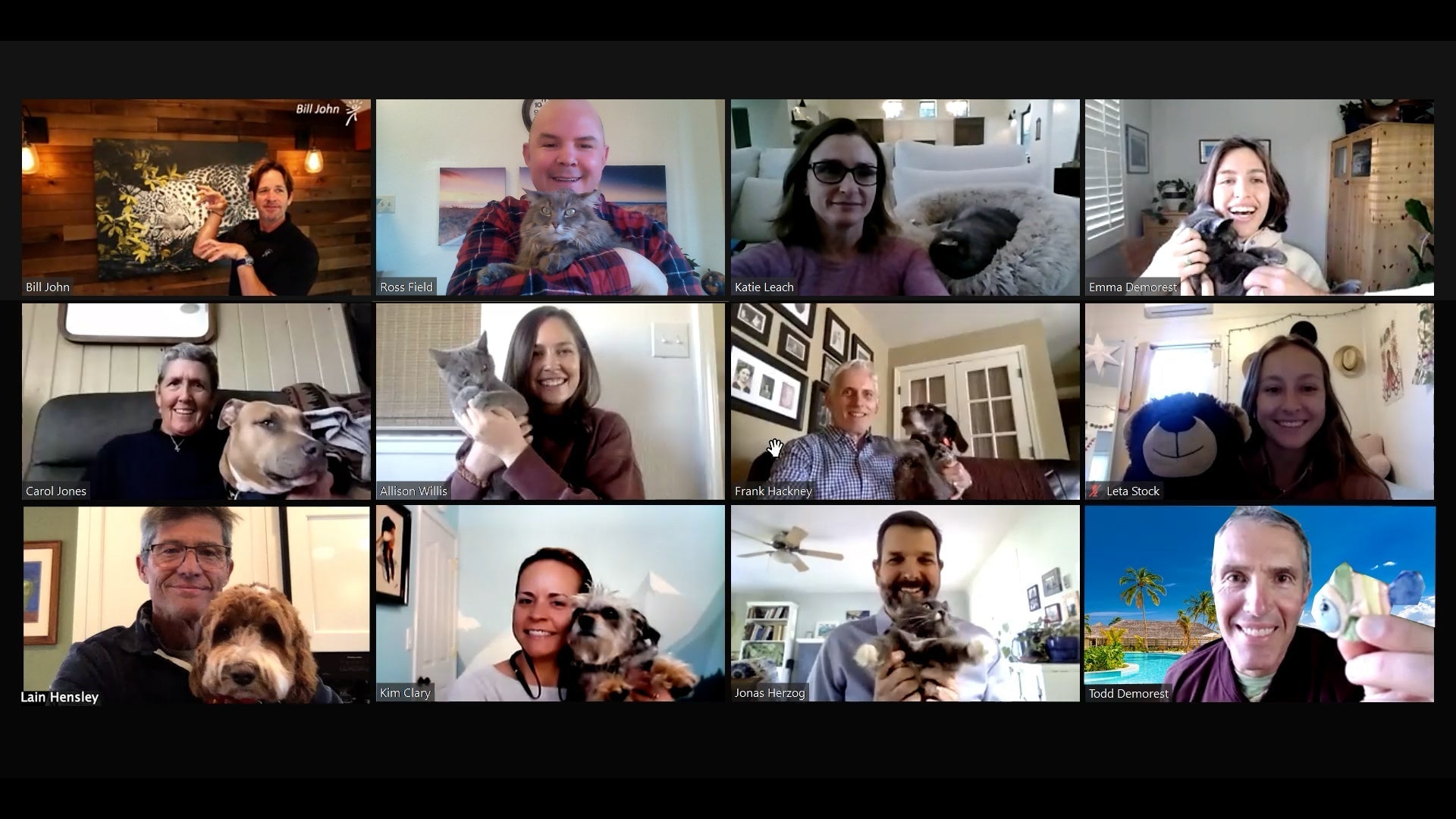Pets in Virtual Meetings: Welcome Distractions or Wildly Misunderstood?
A slightly biased study on the power of pets during the pandemic-induced work-from-home setting.
Recently, during an internal virtual teambuilding activity, Allison’s cat bounded onto her screen. She apologized and quickly moved her feline out of view. But that unexpected cameo shifted the mood of the meeting. We began reflecting on the impact our pets have had on us, our virtual teams, and our business over the past year and a half.
This sparked a few questions:
- How often do pets appear in virtual business meetings?
- Are they a pet-peeve or a welcome distraction?
Nature, Pets, and the Pandemic
I must disclose a personal bias. I’m a California resident, co-owner of Odyssey Teams—a teambuilding and leadership development organization—and a licensed Safari guide in South Africa. Strange combo? Maybe. But not entirely unrelated.
The Safari Guide credential came after extensive study of Southern Africa’s ecosystems, animals, and geography. Inspired by my son’s year-long guide school journey, I followed in his footsteps after a family safari eight years ago. During my practical studies in early 2021, I finally understood why wild places have such a profound effect on our well-being.
I learned:
- Dung beetles can push 1,148 times their body weight.
- Termites are the most successful farmers on Earth.
- Some tree seeds only germinate after passing through an elephant’s digestive tract.
- There are 27 types of fig trees—and 27 species of wasps to pollinate them.
Wild places are vanishing. Wildlife is increasingly scarce. And our pets have become surrogates for nature—especially for those of us living far from it.
Pets as Portals to the Wild
Our yellow lab, Hank, reminded me of the wild I saw on safari. Pets are portals to the natural world we came from. They represent something we need but struggle to articulate.
Why do serotonin levels rise when we pet a dog?
Why are horses used in therapy?
Why do we grab our cameras when we see a bear, dolphin, or hummingbird?
Our pets reconnect us to something ancient and essential. They teach us to be more “natural,” to need less and be more. They remind us of their wildness—and ours.
- The African Wild Dog (Lycaon pictus) thrives on teamwork, just like your dog.
- The African Wildcat (Felis lybica) resembles a tabby cat, independent yet mysteriously bonded to you.
Whether it’s an elephant walking past a safari vehicle or a cat strolling across a colleague’s desk, something shifts inside us—if we’re paying attention.
Survey Insights: Pets in Virtual Business Meetings
We conducted a small survey (sample size: 80) to explore how pets show up in virtual meetings. Here’s what we found:
-
Has your pet ever barged in on camera during a virtual meeting?
Yes: 58 | No: 22 -
Have you seen a co-worker’s pet barge in?
Yes: 71 | No: 9 -
Does your company have a policy about pets in virtual meetings?
Yes: 3 | No: 77 -
Does it bother or distract you when a co-worker’s pet appears?
Yes: 12 | No: 68
For 85% of respondents, pets were neither a bother nor a distraction. In fact, they often sparked connection.
Pets, Policy, and Grace
Only 4% of organizations surveyed had a formal policy about pets in virtual meetings. Most are choosing grace over regulation. As we all learn to navigate remote work, pets may be more than just companions—they may be therapeutic lifelines.
A more scientific study found that dog owners were significantly less depressed than non-pet owners during the COVID-19 pandemic. Pet owners reported more social support and emotional resilience.
Pets as Icebreakers and Culture Builders
US Representative Anita Burroughs shared that her cats often appear during House Committee hearings. “It’s calming,” she said. “It doesn’t distract me. I’m fully attentive.”
Pets are also great conversation starters. According to Purina,
- 6 in 10 people find dog owners more attractive.
- 54% say pets are the perfect icebreaker.
- 1 in 3 prefer dating profiles that include pets.
Final Thoughts: Wildly Welcome or Not?
Pets are important to us for many reasons. They’re ambassadors in our disconnected world and might play a key role in how we work remotely. They could even be the perfect icebreaker for virtual teams.
At Odyssey Teams, where we focus on company culture, team dynamics, and leadership development, it was more than interesting to explore the effects of pets in virtual meetings. Allison’s cat wasn’t just welcome—it may have inspired a future teambuilding event featuring furry and feathered friends.
Next time a pet appears in your virtual meeting, call it out. See where your team stands. And if you’re inspired, send us your thoughts or data—we’d love to hear them.
Written by Bill John, CEO and Co-Founder of Odyssey Teams
References:
PLOS One Study on Pet Ownership and Depression
US Lawmakers Told to Keep Pets Out of Zoom Calls
Purina Survey on Pets and Relationships


Share:
Scrambling to Pivot From an In-Person Meeting to Hybrid or Virtual Programs?
Reprogram Your Mind: How to Overcome Negativity